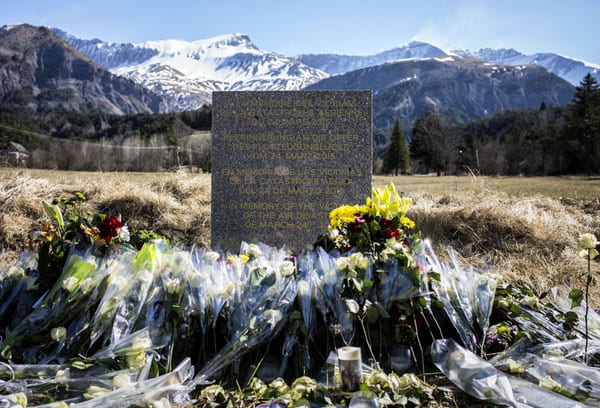BY THOMAS SACCENTE – STAFF WRITER
On March 24, 2015, Germanwings Flight 9525 departed from Barcelona-El Prat Airport in Spain at 10:01 a.m. Central European Time (CET). It was due to arrive at Dusseldorf Airport in Germany by 11:39 a.m. CET, a quick routine flight from one part of Europe to another. However, as it was flying over the French border, the plane began to decrease in altitude at a rapid rate. French air traffic control told the plane to pull up but received no response, causing a military jet to be called in to intercept the plane before it crashed. However, despite these efforts, they were unable to save it and Flight 9525 crashed right into the French Alps below, killing all 150 people on board while the airplane itself disintegrated in the resulting crash. The entire incident occurred within the span of ten minutes.
In the aftermath, several international agencies, including the Federal Bureau of Investigation, and the French and Germancivil aviation authorities, arrived at the crash site to determine the cause of the crash and to recover what remained of the bodies and plane. Once they uncovered the plane’s two black boxes, as well as the sound recordings taken from the cockpit, they made a startling revelation: the crash was not caused by a malfunction in the plane. Rather, they found that the co-pilot, 27-year-old Andreas Lubitz, locked the main pilot, Captain Patrick Sondheimer, out of the cockpit after he went on break, took control of the plane, cut off communications with air traffic control, and intentionally flew it into the Alps, killing everyone onboard including himself. Lubitz worked for Germanwings since 2013, had 630 hours of flight experience, and was considered by friends and neighbors to be a rather quiet character who loved to do his job. Needless to say, this news shocked the world and incited considerable curiosity.
This newfound information led to a breakthrough in the investigation and serves to underscore the bizarre horror of the situation. It seemed so out of place for someone to do. Who was Andreas Lubitz and what compelled him to kill not just himself, but also the other 149 people on board that plane that day? This is not a simple case of suicide, but one of mass murder in which the perpetrator took his own life to achieve this goal. Therefore, the next step in the investigation was to find out more about Lubitz, and to try to understand what was going through his mind at the time of the crash in order to come to some kind of conclusion on how to prevent something like this from happening again. Despite the previously mentioned testimonies to the contrary, post-crash investigation consistently painted a picture of a man constantly struggling with some deep-seated issues.
The first factor to surface in this regard is the fact that Lubitz suffered from serious depression throughout his life. He battled suicidal tendencies for years before the day of the crash and constantly worried that this depression would get in the way of his ability to fly or, in contrast, that he would be fired if anybody found out about it. In 2009, he suffered a depressive episode, which caused him to drop out of his flight training for several months while he received treatment for it. He reported the episode to Lufthansa, Germanwings’ parent company, and repeated classes several times to complete his training. In addition, according to BBC News, it was around this time that a doctor recommended that Lubitz undergo regular medical inspections, and his pilot’s license record added the incident. Furthermore, Kathrin Goldbach, Lubitz’ ex-girlfriend of eight years, provided authorities with many accounts of his erratic behavior from their time together. She described how Lubitz went through severe mood swings at random times and how she worried increasingly for her safety because of this. Despite this, she thought he would eventually get better and that a good life would be spent together. She continued to live with him at the time of the crash.
In addition, there was a point in which Lubitz actively tried getting help for his mental issues. Throughout the course of his career he saw several doctors and took antidepressants to help combat the symptoms of his condition. Nevertheless, as time went by, his fears about his mental state resurfaced. Multiple psychiatrists repeatedly informed him that he was unfit to fly and that he should seek further treatment. Soon afterward, Lubitz quit taking his antidepressants and continued to not tell his employers about his deteriorating circumstances.

Assistant Professor of Psychology Dr. Aaron Godlaski speculates that the sheer number of psychiatrists Lubitz visited over the years indicates that he was trying convince himself that he did not have a problem, that both his psyche and his job position were secure. “If someone is repeatedly going to different doctors and being told the same thing over and over again and then going to more doctors and being told the same thing, he’s clearly looking for a doctor that is going to tell him what he wants to hear, which is, ‘There is nothing wrong with you. You’re fine. You can do your job,’ and he clearly wasn’t hearing that, so he kept seeking out these second opinions and seeing these
The investigators then attempted to uncover the exact nature of Lubitz’ condition during the moments leading up to the plane crash. Specifically, they wanted to know whether Lubitz originally planned to crash the plane, or if he suffered a sudden depressive episode while flying the plane that compelled him to crash it into the mountains. This question was soon answered after recovering Lubitz’ tablet computer from his apartment after the crash. It showed that Lubitz previously researched both methods for suicide and the security measures of cockpit doors in the week before the crash, specifically the cockpit doors of the planes that he usually piloted. Further records taken from the plane’s second black box showed that Lubitz deliberately accelerated the plane’s descent in order to crash into the mountains faster.
However, despite all of these investigations, there is still one major question that remains: If Lubitz wanted to kill himself, why did he subject 149 other people to the same fate? These questions are not likely to be answered as nothing found in Lubitz’ home gives any indication as to why he took his life in this way. He did not even leave a suicide note.
Regardless of Lubitz’ motivations, these events have left a major impact around the world, especially in the area of air travel. In the wake of all these deaths, there are many who tried to lay blame on someone or something for allowing this to happen, saying that crashes such as Germanwings 9525 would not occur if more rigorous safety protocols were in place. For example, many people hold Germanwings responsible for the resulting plane crash, blaming them for maintaining inadequate procedures that, if updated, possibly could prevent the disaster. Therefore, both Germanwings and other airlines from other countries made several modifications to their regulations to safeguard against a horrific accident happening again in the future. The primary example of this is the introduction of a new rule stating that there should always being two pilots in the cockpit at all times. This will prevent one of the pilots from locking the other out of the cockpit and gaining control of the aircraft in the way that Lubitz did.
Others have focused on the way in which Lubitz was able to hide his conditions from his employers. After Lubitz’ mental issues became public, people called for stricter psychological screenings for airline pilots and accused Germanwings of not upholding a rigorous screening process.
Assistant Professor of Psychology Jan Wertz stated that while Germanwings knew that Lubitz took a leave of absence during his training and needed to follow up on it more rigorously, depression is very hard to detect and it is unlikely that Lubitz’ condition made itself apparent. “Mental health issues are difficult, and the biggest part that makes them difficult to diagnose is that a person must be forthcoming. A lot of the symptoms are self-reported, so could [Germanwings] have done something? Maybe, but it’s not like catching some type of physical disease where we can do a blood test or can’t. If [Lubitz] was intent on hiding his depression and if the people who were working with him…were not willing to break confidentiality, I think the company was, in a way, limited,” Dr. Wertz said.
The crash of Germanwings Flight 9525 is a horrific example of the random chaos that plagues the world. It demonstrates that acts of mass murder can occur without warning and how innocent bystanders can be killed as a result of untreated mental illness.
The crash of Germanwings Flight 9525 is a tragedy with which countless people from all over the world are still trying to come to terms. There are still people who are trying to pin the incident on a select few factors, still trying to find someone or something to blame so that it can never happen again. However, despite all of the revelations and discoveries about what occurred that day and how many theories have been formed about Andreas Lubitz’ motivations, it is impossible to pin this incident to a single cause. It came about as the result of a variety of factors that, in all likelihood, could not have been prevented with absolute certainty. The best that can happen is that Germanwings and other airlines improve on oversights that permitted Lubitz to continue flying and for people to hope that this will be enough to prevent a tragedy of this caliber from ever occurring in the future.
